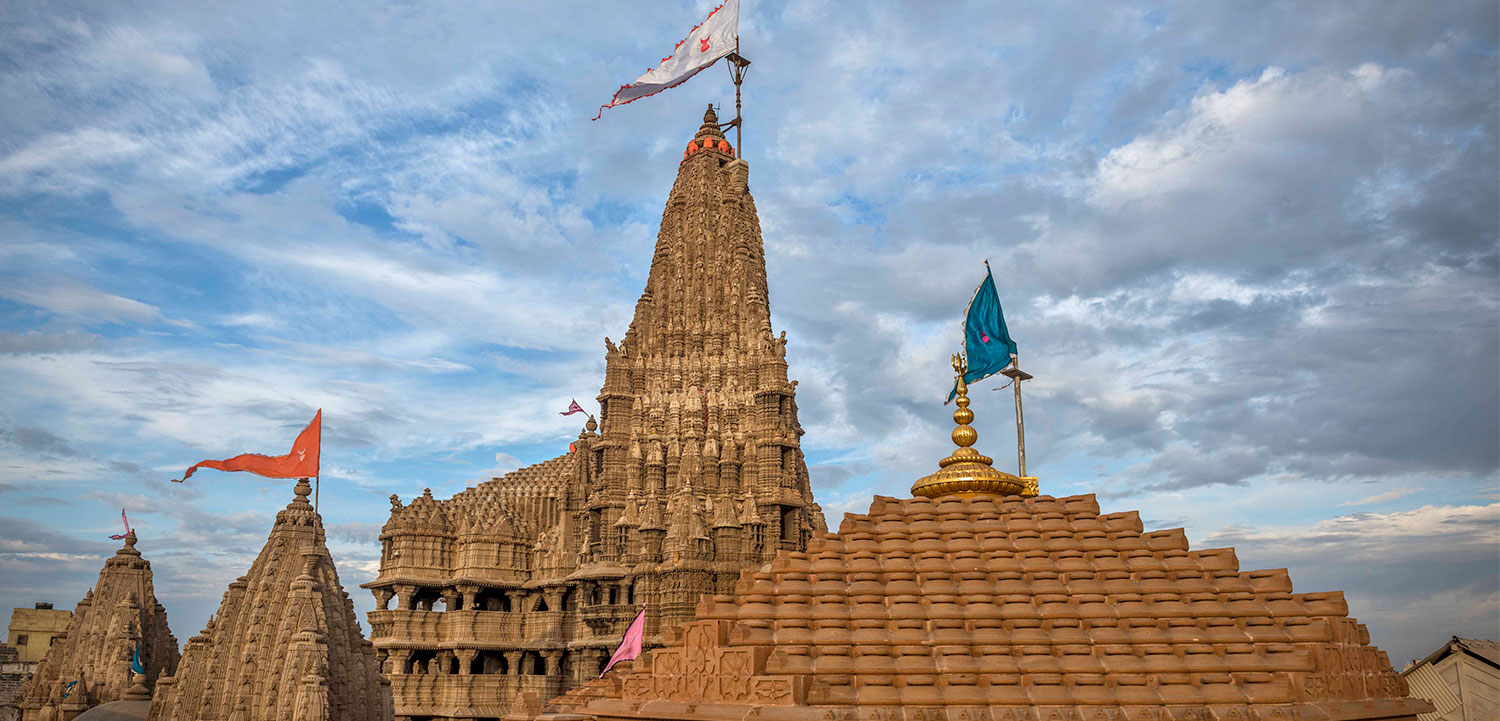
Dwarkadhish Temple, Gujarat
Lord Krishna: The Dwarkadhish Temple
Hinduism believes in idol worship and the temples are built with holy rituals so the devotees can experience the grace of deity and peace. The temples in India make one feel serene as every inch of the temple tells a story and has religious significance behind it making one feel the presence of god. One such temple is the legendary temple in the ancient city of Dwarka, dedicated to Lord Shree Krishna the Dwarkashish Temple that was built on the grounds where the lord stayed and ruled.
The Dwaraka Krishna Mandir is also known as Jagat Mandir, which is a predominant Hindu pilgrimage or Char Dham destination. Dwarka is situated on the banks of the Gomti River and is believed to be the place where Lord Krishna established his kingdom after moving from Mathura. It is a prominent place in the hearts of devotees and is an essential part of Krishna worship in Hinduism, believed to have been built over 2,500 years ago by Krishna’s grandson.
Narrative Behind Dwarka Mandir of Lord Krishna in Gujarat
The history and origin of the temple are related to the Mahabharat era, Dwarka was an island reclaimed by Lord Shree Krishna after he left Mathura. He ruled there for several years as Dwarkadhish. After the Lord left this material world most of his clan was destroyed yet his great grandson Vajranabh built this temple as his dedication, respect, and devotion to the lord at Gomti Creek, making it revered Devbhumi Dwarka for ages to come.
It is said that the original temple of Shri Dwarkadhish submerged underwater and the recent standing is another version of the original temple. The famous Dwarkadhish Ji Ka Mandir has a long, illustrious history and Lord Krishna Dwarka Temple went through destruction, renovation, and rebuilding phases many times over the years, and the present Dwarka Temple in Gujarat is a result of the 1730 reconstructions.
If we talk of history according to Hindu scriptures Dwarka encountered a host of natural disasters after Krishna left that day Dwarka was submerged. The Dwarka Temple place was found underwater around the 20th century. The precise date when the Dwarka Dheesh Mandir was built is not known with absolute certainty, and we can trace the origin and history of the Dwaraka Temple in Gujarat many centuries back.
Essence of Dwarka Mandir And Its Architectural Beauty
The architecture of the Dwarkadhish Temple in Dwarka Gujarat is a blend of traditional Hindu temple architecture and regional influences. The chief deity of the temple is Lord Krishna in his form as the King of Dwarka, also known as Dwarkadhish. It is a highly acclaimed pilgrimage destination of the Hindus since it is a monastery or Chardham established by the spiritual Guru Adi Shankaracharya.
The temple’s main hall and sanctum sanctorum houses the idol of four-armed depiction of Lord Krishna. The main complex is organized in a way that allows devotees to move through various chambers and halls while progressing towards the central sanctum. The temple layout consists of multiple courtyards, pillared halls, and shrines dedicated to different deities. The architectural style is predominantly Rajasthani and Chalukyan, with influences from various dynasties and periods. One of the most striking features of the Dwarka Ji Mandir is its towering shikhara which is adorned with intricate carvings, sculptures, and decorative elements, helping to convey the stories and teachings associated with the deity.
The Dwarka Main Temple is positioned near the shore, making it a prominent landmark in the town. Dwarkadhish Mandir time begins at morning 6.30 and pujas or prayers are offered until 1 P.M, the temple again reopens for pilgrim visits and darshan from 5 in the evening to 9.30 P.M.
One can reach there by air the nearest airport to Dwarka is the Jamnagar Airport, even the trains run regularly to and from Dwarka, making it a convenient mode of transportation. Dwarka is accessible by road from nearby cities and towns, state-run buses and private buses connect Dwarka to various parts of Gujarat. While visiting Dwarkadhish temple one can even enjoy the nearby tourist locations like Nageshwar Jyotirlinga Temple, Rukmini Devi Temple, Somnath Temple, and Bet Dwarka, or enjoy the Beach.
Location
The Dwarka Main Temple is in Dwarka in Gujarat, India. The temple is positioned near the shore, making it a prominent landmark in the town.
Darshan Timing & Festival
Open Close Timing : |
Generally from 6:30 Morning, Evening Times may Vary (check the website) |
Festivals : |
Janmashtami, Diwali, Holi |
Temple Information
Basic Services : |
Prasad, Darshan, Aarti, Abhishek, Accommodation, Eateries, Social Activities |
Organized By : |
Dwarka Mandir Prabhandak Committee |
Dedicated To : |
Shri Krishna |
Architecture : |
Maaru Gurjara Style, Chalukya Style |
Photography : |
Not allowed |
Entry Fee : |
No |
How To Reach
Address : |
Dwarkadhish Temple Dwarka, Devbhoomi Dwarka, Gujarat 361335 India |
Roads : |
Dwarka is well-connected by road and can be reached by both private and public transportation. Dwarka is well-connected by road and can be reached by both private and public transportation. The distance between Dwarka and major cities in Gujarat:
|
Nearest Railway : |
The nearest railway station is Dwarka Railway Station and Trains like the Dwarka Express and Okha Express connect Dwarka to other parts of Gujarat and India. |
Nearest Airport : |
The nearest airport to Dwarka is Jamnagar Airport (IATA: JGA), which is approximately 145 kilometers (90 miles) away from Dwarka. |
Website : |
https://www.dwarkadhish.org/devasthan-samiti/members-of-the-committee/ |
Social Media : |




















